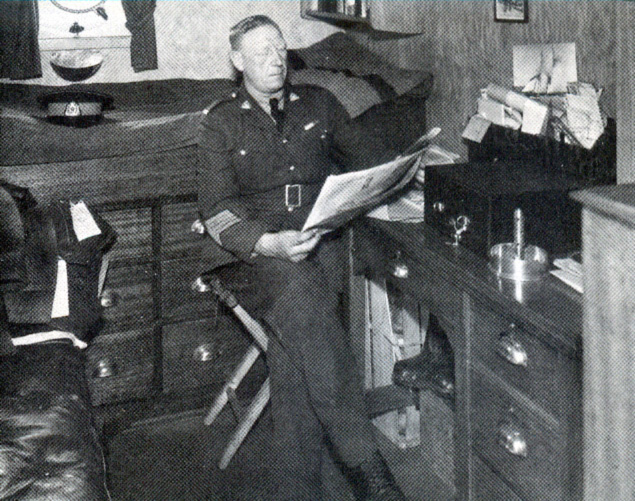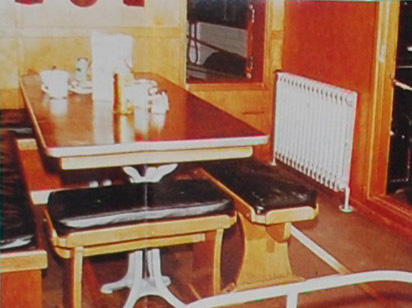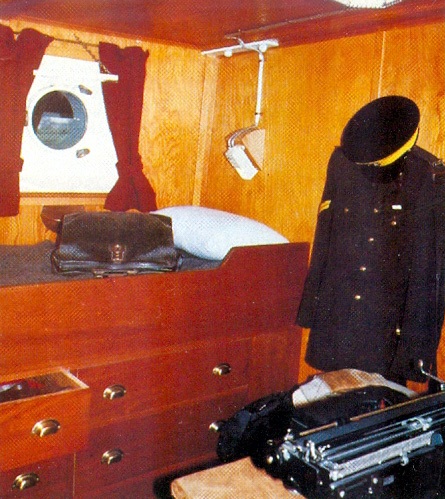 |
| Captain Henry Larsen in his office aboard the St. Roch. (Undated VMM photo) |
This document is intended to showcase the interaction of St. Roch radio with the people in the Arctic community. Key extracts from the 1.000+ page memoirs of Henry Larsen are posted in the second section. These were provided by Doreen Riedel , daughter of Henry Larsen.1) ST. ROCH WIRELESS OPERATORS
| LAST NAME, INITIALS | RANK | YEARS OF SERVICE | CALL SIGN |
| Sealey, F.W. | Special Cst | 1928-1929 | VE7CBK, (post WWII) |
| Holt, H. | Special Cst | 1930 (Evacuated due to appendicitis) | |
| Duke, J.E. | Special Cst | 1930-1933 | VE5EM [1] |
| Davies, J.H. | Cst | 1933-1934 | VE5JV |
| Welsh, T.F.D. | Cst | 1935-1937 | VE5PM, VE7AQT (post WWII) |
| Josephson, V.R. | Cst | 1938-1939 | |
| Hadley, E,C. (Dean) | Cst | 1940-1942 | VE4EF [1] and VE3KH |
| Marshall, W.E. | Cst | 1943 | VE5PZ, and VE4Wl (pre WWII) |
| Russill, L.G. | Special Cst | 1944 | |
| Smith, L.C. | Civilian Employee | 1945-1946 | |
| Sargent, G.K. | Cst | 1947 to Jul 1948 | |
| Beattie, R.L. | Special Cst | 1948 | |
| ? | ? | 1949 | |
| Gingell, J.A. or J.N. | Special Cst | 1950 | |
| Driscoll, W.F. | Special Cst | 1951 | |
| ? | ? | 1952 | |
| Marshall, W.E. | Cst | 1953 | Same as above |
| Braun, W.A. | Special Cst, later Sgt. | July 1954 |
[Note 1] : The Pre WWII VE5 call sign prefix covered British Columbia and the North West Territories. VE4 covered Manitoba and Saskatchewan, pre WWII .Other Arctic amateurs in regular contact with the St. Roch were :
Parsloe, T. VE5EB
Riddle, R. W. VE5JZ
Wild, R. S. VE5CYJohn Duke was in contact with VE4AV, Mrs. E B How, 2301 W First Ave, Prince Albert Sask during 1933-35.
This radio ops listing was researched by John Gilbert 11 Nov, 2019
2) EXTRACTS FROM THE MEMOIRS OF HENRY LARSENPage 451 (1930-31)
During many long stormy and cold nights when not on the trail, the radio was a wonderful help and diversion from the monotony and we all had our favorite programs. The singer. Kate Smith was then in the lime light. with her many popular songs of the times. one of which was "When The Moon comes Over The Mountains". Well... Const. Scotty Blues became so enamored over Kate Smiths voice and that song. that he talked of nothing else for days, and finally sent a wire to Kate with a special request for her to sing the song, also send a photograph. None of us had the faintest idea what Kate Smith looked like, but Scotty was full of imagination, and became the object for a good deal of good natured ribbing from the rest of the boys for constantly humming Kate's songs. With our old radio set of those days operated by batteries, we had wonderful receptions, much better than in later years when we received more modern and up to date sets. The Northern messenger was a program from Edmonton, Alberta. broadcasting personal messages to the north every Saturday night after midnight, and most of us received personal messages from friends and relatives that way. This was of great benefit to almost everyone in the Arctic those days when mail service was only once or at most twice a year. The broadcasting stations co-operated fully over the many years I served in the Arctic. Even certain U.S. station relayed or broadcast messages at certain nights and times. Many broadcasting stations then, asked for listeners in outlying areas to write in or wire if possible, the location of the listeners and give any information he wished regarding the program and reception. This was a useful thing as it gave the stations a good deal of information as to the range and strength of the broadcasts.
 |
| Captain Henry Larsen in his office aboard the St. Roch. (Undated VMM photo) |
Page 529 (1935 )Then there was a Scott named Tommy Welsh who had never seen a ship except the one he came over from Scotland in a few years before. Prior to joining the force he had served a short while in the Scots Guards. He was an amateur wireless operator and as such was officially assigned as our wireless operator
Page 534 (1935)
Tommy turned out to be an able fellow and a good operator. He even issued a biweekly newspaper. He was an ardent amateur operator and collected news from every corner of the globe.
Page 572 ( Nov 1935)
Tommy Welsh by now had the wireless working properly and we had two schedules a week with Coppermine for transmitting. That was the only two days a week we had electric light because the little Kohler engine had to be running for transmitting power. Tommy could of course listen in to and receive messages at set hours if any. He had also rigged up a small amateur set and enjoyed himself communicating with other radio hams from several comers of the globe. all of whom he traced out on a map of the world that I gave him. He was not an outdoors man but turned out very good as a radioman, a thing which seemed unbelievable during our journey north. Now every night he produced at least two typed pages of news. There had been reports of measles amongst several Eskimos during the summer, and measles are in many cases fatal to Eskimos without assistance and medical help from the few whites in the country. At that time there were no medical men or nursing stations in that part of the Arctic and no ways of communicating except by the St. Roch and the Coppermine radio, also the H.B.C. post at Bathurst Inlet where the manager also operated a amateur set and with whom we were in contact. Now the symptoms of this dreaded disease began to make it's appearance.
Chess became very popular during the winter, and even though only two can play, there were no lack of spectators giving free advice .Frank Willan had never played this game before and although it took him some time to catch on, being a stickler for detail and accuracy, he began to study the game in earnest by reading up on it in our large Dictionary and EncyclopedIa and in a couple of months became one of the tops. He even played over the air with one of the remote Hudson's Bay Post managers. also fond of the game. One or two moves by Frank per week were made through Tommy Welsh on the ham radio, whilst the Hudson's Bay man had his own radio.
Page 585 (1935)
It was clear all day and the thermometer indicated thIrty-five below. In the afternoon Tommy Welsh broadcast a program over the ship's station to residents in the western Arctic. Luckily RC.M.P. Headquarters in Ottawa were out of listening range. The St. Roch was not supposed to use their power and supplies for celebrating Christmas like that.
Page 605 (1936)
News was of great importance to the people of the north those day and during the late evenings people generally clustered around the radio. The mail plane was late in arriving. held up by bad weather. short days and very little visibility. In those days there was no radio aid to flyers in the north. The pilots would have to stick their nose out in the morning before daylight, peer into the sky and judge what the weather would be like in an hour or two. If they thought it would be favourable the blowlamp would be lit under the canvas hood in order to warm up the engine taking quite a while at fifty below zeroPage 691 (1937)
We had not been able to contact Coppermine by wireless about our whereabouts or the predicaments we had gone through nor of the loss of the Fort James. Due to atmospheric conditions, which Tommy Welsh called "Radio Blackout, communication of any kind had been impossible.
Page 780 (1937)
On Christmas Eve we had excellent radio reception and heard the messages being broadcast to the North through the C.B.C. Broadcasting Northern Messenger Service. Each one of us had a personal message from our home and loved ones. I heard my wife and little daughter speaking very clear and distinctly to me from Vancouver. Commissioner S.T. Wood also sent a personal message to us as well as to all the other R.C.M.P. detachments in the Arctic. The radio broadcast certainly proved a blessing to the people in the Arctic over those years and the reception was at all times very good. We had our favorite programs we followed besides the news broadcast and the war news was followed very keenly. We could get broadcasts from Canada, the U.S.A. and from Europe. The B. B.C. from London came in very clearly, so did Berlin. The broadcast in English by Lord HaHa was always entertaining. One thing we enjoyed from Berlin was the lovely musical programs. Quite often I could pick up a Swedish station and so listen to the comments from a neutral commentator.
Page 811 (Oct 1941)
.We also now had established bi-weekly radio schedule with Coppermine and soon all everyone in the Arctic had news of our where about. Our old friend Lawrence Learmonth the H.B.C. post manager at Gjoa Haven some 200 miles away, could hear our broadcast, but had no transmitter to answer back.
Page 861 (May 1942)
Nor had we heard any news since leaving Fort Ross. The radio was a god~send denied . The oldtime explorers; we could get all the world news in a matter of minutes. Our interest naturally centered on the progress of the war. Reception waS perfect and we could listen to almost any station we wished.... European, , American and Canadian. Of special amusement were the broadcasts of Lord Haw Haw. His antics and propaganda were always of interest, but we found it difficult to believe that his mouthings could deceive anybody. However his Berlin station provided some excellent music which we enjoyed. Our wireless operator, Dean Hadley, was a clever young fellow who was constantly tinkering around, improving receivers, even building a second set from spare parts, which gave very good results.
 |
| Messing area for the crew. (VMM photo) |
 |
| St. Roch - clerk's cabin (VMM photo) |
3) QSL CARDSAs stated in the main St. Roch document, there is no evidence that the vessel was assigned a permanent amateur radio call sign, therefore , no QSL cards would exist. There is no evidence to indicate that a QSL card for VGSR was ever produced. The closest correspondence to a QSL card was this letter from Jack Duke VE5EM to VE4AV which confirmed their QSO:
RCM Police Schooner St. Roch
RCM Police
Aklavik, NWTJuly 27th/1931
VE4AV
Dear Mrs. How 1,
Very many thanks for your card just received. We only receive two mails a year – hence the delay.
As you possibly know, we patrol the Arctic coast and re-provision the police detachments during the very short navigation season and freeze in at Tree River in the winter. My ham junk is a 50 watt Hartley with Hertz aerial rigged from a pole on the ice as soon as we freeze in. I’m going to buy a voltage fed Zepp this winter. We may be wintering at Herschel Island this year but wherever we are I will sure look for you. I’m sorry if I called you “OM”. You are the first lady operator I’ve had the pleasure of QSO to. Mail and radio are our only comfort in this neck of the woods and mail is few and far between.
I also broadcast to police detachments along the coast on 500 meters with a 100 watter and have the usual 600 ships wave CW and ICW.
Our winter mail comes from about 6000 miles by dog team so leaves the outside in November and reaches us in April, hi!
We had quite a good trip west to Herschel where we are at present waiting for the S S Baychimo from Vancouver – then we proceed East to Cambridge Bay, Victoria Island.
Just got the dope through about Lindy’s flight and hope to be able to help him out as he is equipped with wireless and will fly over here.
Hope to hear from you again. Radio is sure great fun eh. Good luck YL.
Very 73,
Jack Duke op VE5EM & VGSR.**********
1 VE4AV, Mrs. E B How, 2301 W First Ave, Prince Albert Sask.Transcribed by John Gilbert 21 Nov 2019.
Transcript. Credit VMM St. Roch Research Collection. Series 2.3 Box 9 Folder 33 Duke, John E. 1992.
Dec 25/19